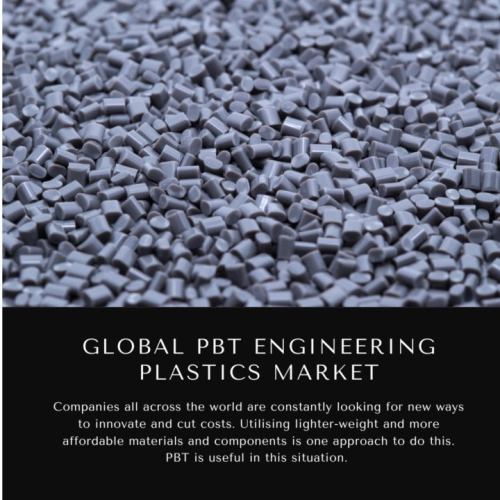
- Get in Touch with Us

Last Updated: Apr 25, 2025 | Study Period: 2024-2030
Companies all across the world are constantly looking for new ways to innovate and cut costs. Utilising lighter-weight and more affordable materials and components is one approach to do this. PBT is useful in this situation.

PBT is employed in a number of sectors, including the automobile and electronics industries. PBT components are expected to be used in the majority of high-end engineering applications.
PBT, or polybutylene terephthalate, is a thermoplastic compound with a semi-crystalline structure that is employed in engineering. Its composition and characteristics are comparable to those of PET (Polyethylene Terephthalate).
In addition, PBT belongs to the family of polyester polymers. Terephthalic acid is used in a procedure known as polycondensation to create this substance. Additionally, 1,4-butanediol and dimethyl terephthalate can be used to make it. This approach, however, has to be produced using a unique catalyst.
Additionally, the advantages of polybutylene terephthalate contribute to its growing commercial success.
The Global PBT Engineering Plastics Market accounted for $XX Billion in 2021 and is anticipated to reach $XX Billion by 2030, registering a CAGR of XX% from 2022 to 2030.
Using ocean-bound polyethylene terephthalate (PET) bottles as a feed stream for chemical upcycling into resin, Sabic has introduced a polybutylene terephthalate (PBT) engineering plastic.
Mismanaged garbage that comes from within 30 miles of the coast and is most likely to end up in the ocean is referred to as "ocean-bound plastic."
LNP Elcrin WF0061BiQ, the new grade, is the most recent addition to Sabic's line of chemically upcycled LNP Elcrin iQ materials, which promote circularity and may be used as drop-in replacements for virgin PBT resins.
| Sl no | Topic |
| 1 | Market Segmentation |
| 2 | Scope of the report |
| 3 | Abbreviations |
| 4 | Research Methodology |
| 5 | Executive Summary |
| 6 | Introduction |
| 7 | Insights from Industry stakeholders |
| 8 | Cost breakdown of Product by sub-components and average profit margin |
| 9 | Disruptive innovation in the Industry |
| 10 | Technology trends in the Industry |
| 11 | Consumer trends in the industry |
| 12 | Recent Production Milestones |
| 13 | Component Manufacturing in US, EU and China |
| 14 | COVID-19 impact on overall market |
| 15 | COVID-19 impact on Production of components |
| 16 | COVID-19 impact on Point of sale |
| 17 | Market Segmentation, Dynamics and Forecast by Geography, 2024-2030 |
| 18 | Market Segmentation, Dynamics and Forecast by Product Type, 2024-2030 |
| 19 | Market Segmentation, Dynamics and Forecast by Application, 2024-2030 |
| 20 | Market Segmentation, Dynamics and Forecast by End use, 2024-2030 |
| 21 | Product installation rate by OEM, 2023 |
| 22 | Incline/Decline in Average B-2-B selling price in past 5 years |
| 23 | Competition from substitute products |
| 24 | Gross margin and average profitability of suppliers |
| 25 | New product development in past 12 months |
| 26 | M&A in past 12 months |
| 27 | Growth strategy of leading players |
| 28 | Market share of vendors, 2023 |
| 29 | Company Profiles |
| 30 | Unmet needs and opportunity for new suppliers |
| 31 | Conclusion |
| 32 | Appendix |